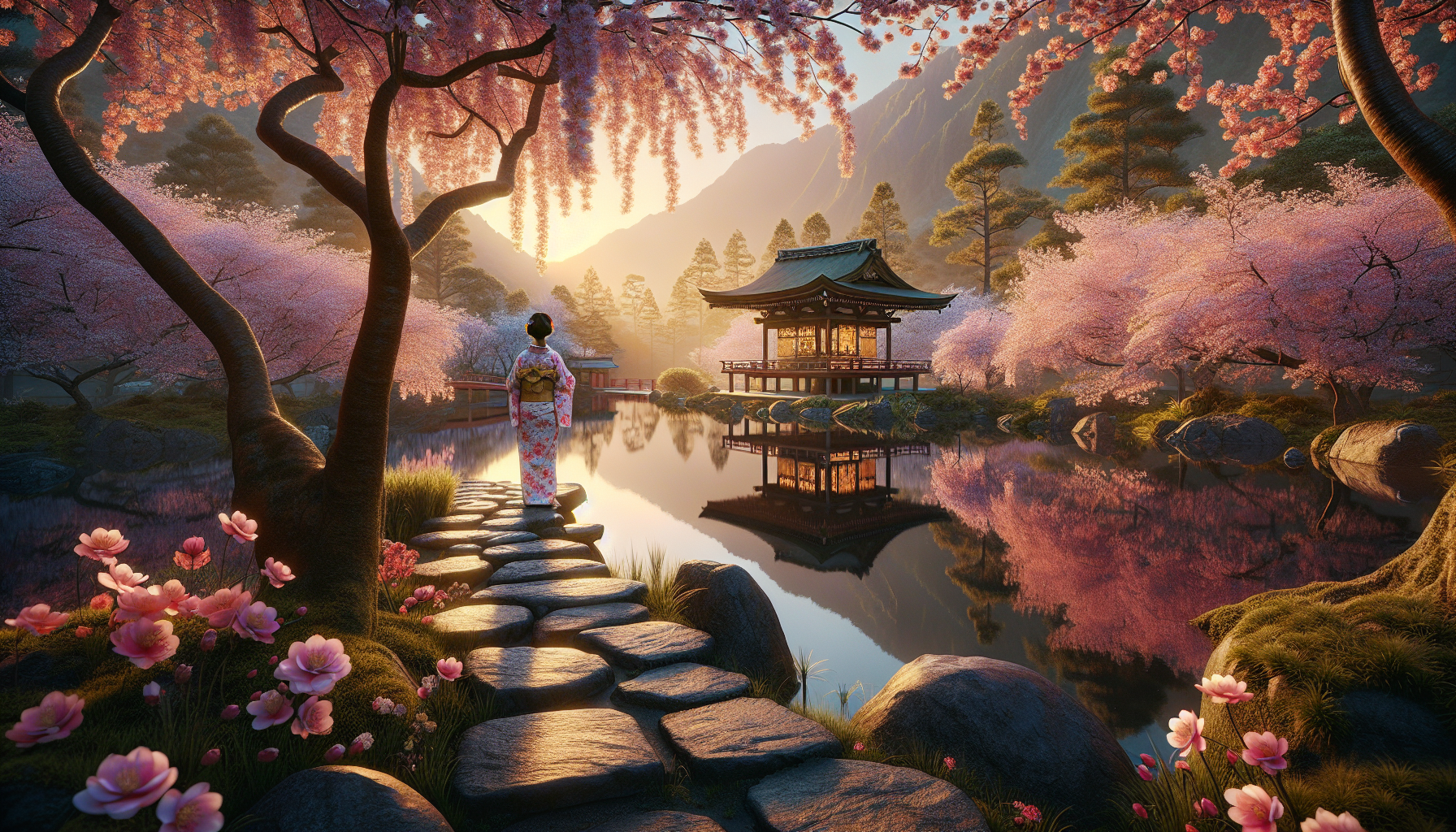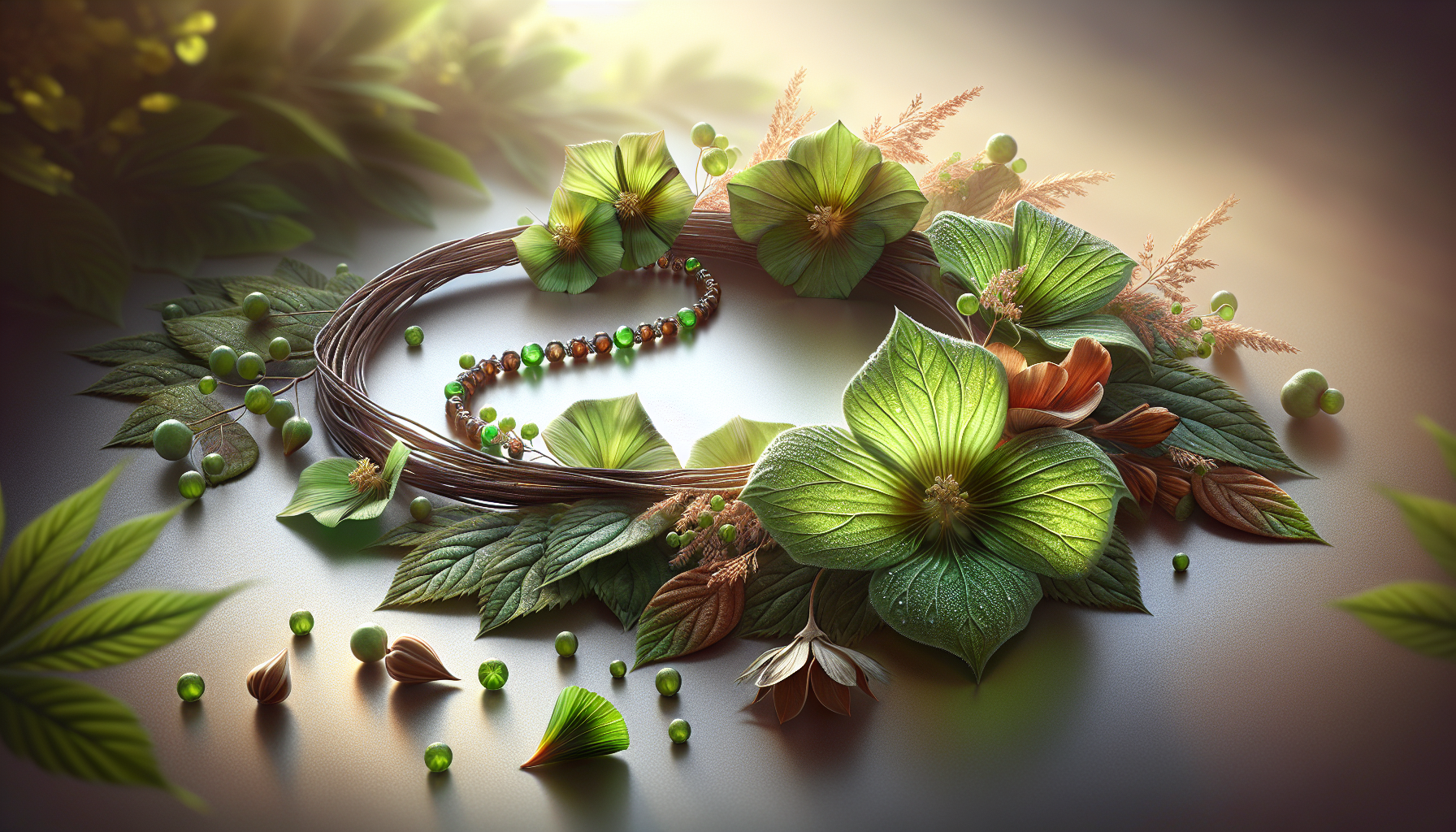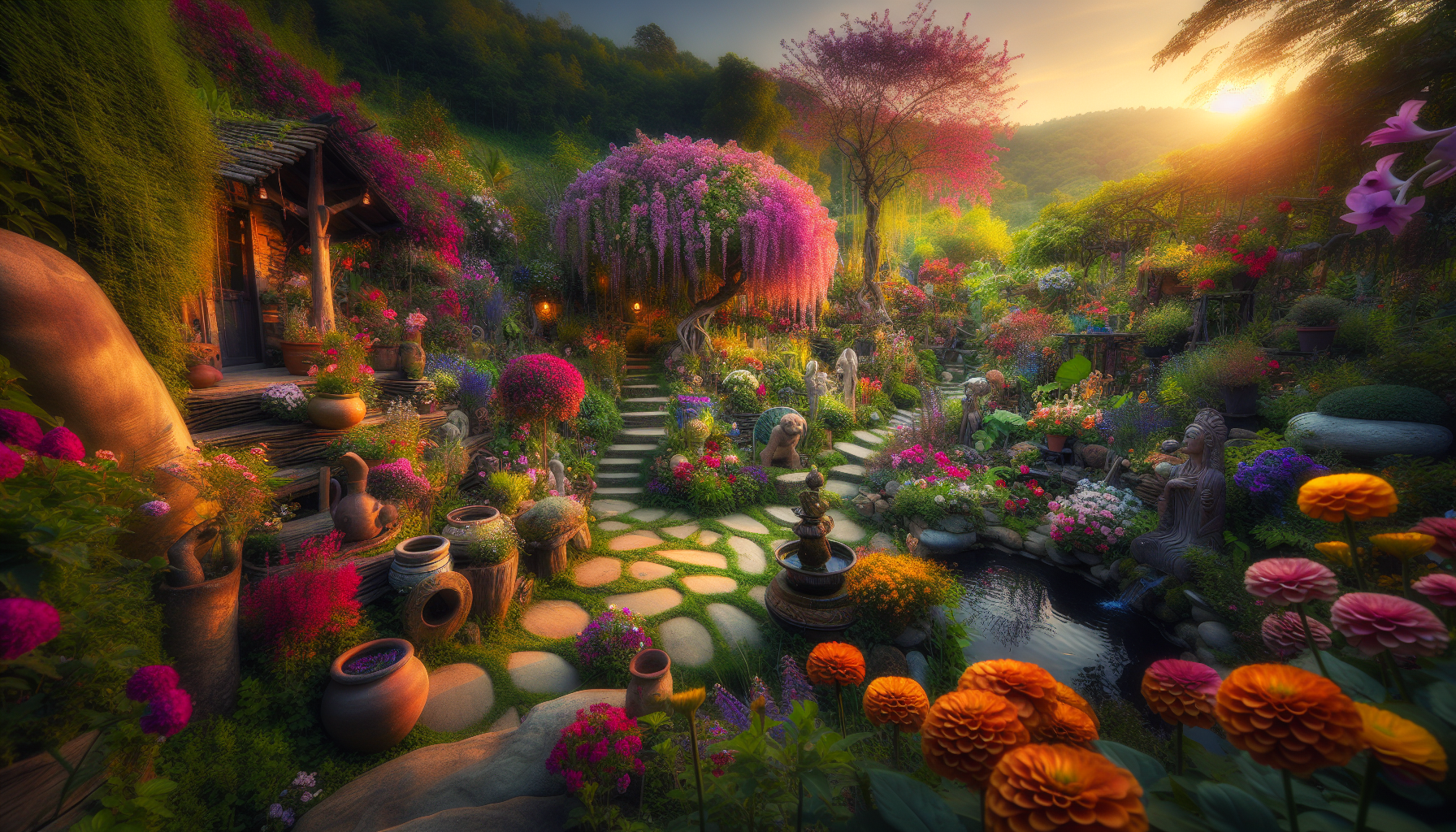Anúncios
In the heart of Japan, where tradition and modernity dance in a delicate balance, flowers hold a revered place, weaving through the cultural, spiritual, and aesthetic fabric of society. This profound connection between the Japanese people and flowers is not merely a casual appreciation of nature’s beauty; it is a complex, centuries-old dialogue that continues to flourish in contemporary life. The significance of flowers in Japanese culture, or “hana,” transcends simple adornment, embodying ideals, emotions, and philosophies that are integral to the nation’s identity. 🌸
Anúncios
Our journey into the world of Japanese flowers begins with the iconic cherry blossom, or “sakura,” which epitomizes the transient nature of beauty and life itself. Every spring, these delicate pink petals blanket the country in a breathtaking display that captivates locals and tourists alike. But beyond their visual appeal, sakura symbolize the ephemeral nature of existence, a concept deeply rooted in Buddhist philosophy. The fleeting bloom of the cherry blossom serves as a poignant reminder of life’s impermanence, encouraging a mindful appreciation of the present moment. This seasonal spectacle is celebrated with “hanami” festivals, where communities gather under blooming trees to reflect, rejoice, and renew bonds.
Yet, the significance of flowers in Japan is not limited to cherry blossoms. The chrysanthemum, or “kiku,” is another revered bloom, holding a place of honor as the symbol of the Imperial family. Its layered petals are seen as a metaphor for perfection and longevity, values that resonate throughout Japanese history. As you delve deeper into the cultural landscape, you will encounter the refined art of “ikebana,” the practice of flower arranging that transforms simple blooms into profound expressions of harmony and balance. Unlike Western floral arrangements, ikebana is not merely about the final visual result; it is a meditative practice that reflects the arranger’s internal state and fosters a deeper connection with nature. 🌿
Anúncios
The role of flowers extends into the realm of communication, where they convey sentiments that words often cannot. The Japanese language of flowers, or “hanakotoba,” assigns specific meanings to different blooms, enabling individuals to express emotions and messages in a subtle, elegant manner. From love and gratitude to apologies and farewells, flowers become silent messengers in a society that values nuance and discretion. This floral lexicon enriches social interactions and endows personal relationships with an added layer of depth and meaning.
Throughout this article, we will explore these fascinating aspects of Japanese floral culture in greater detail, uncovering the historical roots, symbolic meanings, and contemporary manifestations of flowers in Japan. We will also examine how these traditions influence various art forms, such as poetry, painting, and tea ceremonies, and how they continue to evolve in the face of modern challenges. By the end of this exploration, you will gain a deeper appreciation for the role of flowers in Japanese society, and perhaps, find inspiration in their enduring beauty and wisdom. 🌺
## The Symbolic Essence of Flowers in Japanese Culture
In Japan, flowers hold a profound significance that transcends mere aesthetic beauty. These delicate blooms are interwoven with the fabric of cultural identity, spiritual beliefs, and historical narratives. As we embark on this journey through the verdant landscapes of Japanese culture, we delve into the symbolic meanings, traditional practices, and contemporary interpretations of flowers, unveiling their essential role in the nation’s life.
### The Cultural Significance of Cherry Blossoms
Cherry blossoms, or *sakura*, are perhaps the most iconic of all Japanese flowers, deeply embedded in the country’s cultural consciousness. Every spring, these ethereal blooms transform landscapes into breathtaking vistas, attracting millions of people who partake in *hanami*, the traditional custom of flower viewing.
#### Hanami: A Celebration of Ephemeral Beauty
The practice of *hanami* dates back over a thousand years and is a cherished tradition that celebrates the transient beauty of cherry blossoms. This celebration is not merely about enjoying the visual spectacle; it is a time for reflection on the fleeting nature of life. The blossoms, which bloom briefly before falling, serve as a poignant reminder of life’s impermanence and the beauty that exists in each moment.
For a deeper understanding of this tradition, watch the video: [Cherry Blossom Season in Japan | Only in Japan](https://www.youtube.com/watch?v=9ts8cGYaSg4).
#### The Spiritual Dimension of Sakura
In the realm of spirituality, cherry blossoms hold a significant place in Shinto and Buddhist practices. These flowers are often seen as symbols of purity, renewal, and the cyclical nature of life. In Shinto shrines, cherry trees are revered for their connection to the divine, embodying the spirit of rejuvenation and hope. Within Buddhism, they serve as a metaphor for mindfulness, encouraging practitioners to embrace the present.
#### Sakura in Modern Japanese Society
Today, cherry blossoms continue to influence various aspects of Japanese life, from literature and art to fashion and cuisine. They are depicted in traditional *ukiyo-e* prints and contemporary digital art, symbolizing the harmonious blend of past and present. Additionally, sakura-flavored treats and beverages become ubiquitous in spring, adding a sensory dimension to the flower’s cultural impact.
| Aspect | Traditional | Modern |
|---|---|---|
| Celebration | Hanami gatherings | Cherry blossom festivals |
| Spirituality | Shinto and Buddhist symbolism | Mindfulness and renewal |
| Art | Ukiyo-e prints | Contemporary digital art |
### The Elegance of Ikebana: Japanese Flower Arrangement
Ikebana, the art of Japanese flower arrangement, embodies a philosophy that emphasizes harmony, balance, and a deep connection with nature. Unlike Western flower arrangements, which focus primarily on the blooms, ikebana considers all elements — stems, leaves, and even the vase — as integral components of the design.
#### Principles and Philosophy of Ikebana
The foundation of ikebana lies in its principles, which include balance, harmony, and simplicity. These arrangements are often asymmetrical and feature empty spaces, representing the beauty of nature’s imperfections. This art form encourages a meditative process, allowing practitioners to engage with the natural world and express their emotions through floral composition.
#### The Historical Evolution of Ikebana
Originally, ikebana was a religious offering in Buddhist temples during the 7th century. Over time, it evolved into a more secular practice, becoming an art form appreciated by samurai and nobility in the 15th century. By the Edo period, ikebana had permeated all levels of society, with different schools emerging, each with unique styles and techniques.
#### Contemporary Ikebana: Innovation Meets Tradition
In the modern era, ikebana continues to evolve, with contemporary artists experimenting with new materials and forms while adhering to traditional principles. This fusion of innovation and tradition ensures that ikebana remains relevant, captivating audiences with its serene beauty and timeless elegance.
### The Mystique of Wisteria: Symbolism and Celebration
Wisteria, known as *fuji* in Japanese, is another flower steeped in cultural significance. With its cascading clusters of purple and white blooms, wisteria is celebrated for its elegance and grace, symbolizing love, longevity, and the promise of new beginnings.
#### Wisteria in Japanese Mythology and Folklore
In Japanese mythology, wisteria is associated with the goddess Amaterasu, the sun deity, representing warmth and light. Folklore often portrays wisteria as a protective force against evil spirits, adding a mystical dimension to its beauty.
#### The Fuji Matsuri: A Festival of Wisteria
The Fuji Matsuri, or Wisteria Festival, is held annually in various regions across Japan, drawing visitors to witness the enchanting displays of these flowers. The Ashikaga Flower Park, renowned for its stunning wisteria tunnels, becomes a focal point of celebration, offering a visual feast that captivates and inspires.
For an immersive experience, watch the video: [The Beautiful Wisteria of Ashikaga Flower Park | Japan Travel Guide](https://www.youtube.com/watch?v=F2uXU6qWb9A).
#### The Cultural Influence of Wisteria
Wisteria’s influence extends beyond festivals, inspiring traditional *noh* plays and literature. Its symbolism is often invoked in poetry, where the flower’s delicate beauty is used to convey themes of love and devotion. In modern Japan, wisteria motifs appear in fashion and interior design, reflecting its enduring allure.
| Aspect | Traditional | Modern |
|---|---|---|
| Mythology | Association with Amaterasu | Folklore and protection symbolism |
| Festivals | Fuji Matsuri | Wisteria displays in parks |
| Art | Noh plays and poetry | Fashion and design motifs |
### Camellia: The Flower of Tea and Tranquility
The camellia, or *tsubaki*, holds a special place in Japanese culture, revered for its beauty and association with the traditional tea ceremony. This flower, with its lush petals and vibrant hues, symbolizes humility, discretion, and a refined elegance.
#### The Role of Camellia in the Japanese Tea Ceremony
In the context of the tea ceremony, camellias are used as floral decorations, reflecting the ceremony’s principles of harmony and respect. Their simple, unassuming beauty complements the serene atmosphere, enhancing the experience of mindfulness and contemplation.
#### The Symbolic Meanings of Camellia
In addition to its role in the tea ceremony, camellia carries various symbolic meanings. In literature and art, it represents the concept of unpretentious beauty and the fleeting nature of life. The flower’s resilience, blooming even in winter, is a testament to strength and perseverance, qualities highly valued in Japanese culture.
#### Camellia in Contemporary Japanese Culture
Today, camellia’s influence is evident in modern Japanese aesthetics, from fashion to interior design. Its understated elegance is often sought in minimalist designs, embodying a quiet sophistication that resonates with contemporary sensibilities. The camellia’s cultural legacy continues to inspire and captivate, proving its timeless appeal.
### Chrysanthemum: The Flower of the Imperial Family
The chrysanthemum, known as *kiku*, is a symbol of the Japanese imperial family and represents longevity and rejuvenation. Its significance is such that the chrysanthemum crest is used as the emblem of the emperor, underscoring its esteemed status in Japanese society.
#### The Historical Importance of Chrysanthemum
Chrysanthemums were introduced to Japan in the 8th century and quickly gained prominence. The flower became associated with the emperor during the Nara period, and by the 12th century, it was adopted as the imperial crest. This association has imbued the chrysanthemum with a sense of authority and reverence.
#### Chrysanthemum Festivals and Celebrations
The annual Chrysanthemum Festival, or *Kiku Matsuri*, celebrates this flower’s beauty and cultural significance. During the festival, elaborate displays of chrysanthemums are showcased in temples and gardens, attracting visitors who admire the intricate arrangements and vibrant colors.
#### Chrysanthemum in Japanese Art and Symbolism
In Japanese art, the chrysanthemum is a popular motif, symbolizing elegance and refinement. It appears in traditional *kimono* patterns, ceramics, and paintings, reflecting its deep-rooted cultural significance. The flower’s association with autumn and the harvest season further enhances its symbolic meaning of abundance and prosperity.
#### Contemporary Interpretations of Chrysanthemum
In modern Japan, chrysanthemums continue to inspire, influencing fashion, design, and even pop culture. Their regal beauty and symbolic depth make them a perennial favorite, embodying the spirit of Japan’s rich cultural heritage.
In conclusion, flowers are more than just decorative elements in Japanese culture. They are powerful symbols that encapsulate the nation’s values, beliefs, and traditions. Whether through the ephemeral beauty of cherry blossoms, the artistic expression of ikebana, the mystical allure of wisteria, the tranquil presence of camellia, or the imperial elegance of chrysanthemum, each flower tells a story that enriches the tapestry of Japanese life. As we explore these floral wonders, we gain a deeper appreciation for the intricate connections between nature and culture in Japan, inspiring us to see beauty in all its forms.

Conclusion
In conclusion, the exploration of the significance of flowers in Japanese culture reveals a profound tapestry of history, symbolism, and aesthetic appreciation that continues to blossom vibrantly today. This article has delved into the multifaceted roles that flowers play within Japanese society, from the timeless elegance of cherry blossoms in the celebration of transient beauty to the intricate language of flowers, hanakotoba, which conveys deep emotional expressions. Through these lenses, we see how flowers serve not only as elements of natural beauty but also as integral components of cultural identity and philosophical thought.
One of the key points discussed is the enduring allure of cherry blossoms, or sakura, which have captivated Japanese hearts for centuries. They symbolize the ephemeral nature of life, reminding us of the beauty and brevity of our existence. This concept, known as mono no aware, encourages an appreciation for the fleeting moments, teaching us to cherish the present while acknowledging the inevitable passage of time. The annual hanami celebrations, where people gather to enjoy the blooming cherry trees, highlight the communal aspect of this appreciation and reflect a deep-rooted tradition that fosters social connection and reflection.
Furthermore, the article touched upon the intricate language of flowers, hanakotoba, which offers a unique means of communication that transcends words. Each flower carries its own set of meanings and emotions, allowing individuals to convey messages of love, respect, apology, and more. This tradition enriches personal interactions and adds a layer of depth to relationships, showcasing the cultural significance of subtlety and nuance in communication.
Another significant aspect covered is the role of flowers in traditional Japanese art and aesthetics. From ikebana, the disciplined art of flower arranging, to the depiction of flowers in paintings, poetry, and design, these elements reflect a harmonious balance between nature and human creativity. Ikebana, in particular, emphasizes simplicity, balance, and mindfulness, encouraging practitioners to engage in a meditative process that promotes inner peace and connection with nature.
The article also highlighted the importance of flowers in Japanese religious and spiritual practices. Whether in the context of Shinto rituals or Buddhist ceremonies, flowers are offerings that symbolize purity, respect, and reverence for the divine. They serve as conduits between the human and spiritual realms, embodying the interconnectedness of all living things and the cyclical nature of life and death.
As we reflect on these insights, it becomes clear that the significance of flowers in Japanese culture is not merely a matter of aesthetic appreciation but a deeply ingrained aspect of social, philosophical, and spiritual life. Flowers are woven into the fabric of everyday experiences, offering lessons in mindfulness, impermanence, and emotional expression that resonate universally.
The continued relevance of these traditions in modern Japan underscores their adaptability and enduring appeal. As contemporary society grapples with the challenges of fast-paced living, the appreciation for the natural world and its symbolic meanings offers a source of solace and inspiration. Flowers, with their silent beauty and profound messages, remind us of the importance of pausing to reflect, connect, and appreciate the world around us.
In closing, I encourage readers to embrace the lessons and inspirations drawn from the rich tapestry of Japanese floral culture. Whether it be through learning the language of flowers, practicing ikebana, or simply taking a moment to admire the beauty of a bloom, there is much to be gained from incorporating these practices into our lives. Let us share this appreciation with others, fostering a deeper understanding and connection with both nature and each other.
Your thoughts and experiences are invaluable, so I invite you to comment below with your reflections on the cultural significance of flowers. Have you encountered similar traditions in other cultures, or have you been inspired to explore these practices further? Share your insights and stories, and let’s continue this conversation.
If you found this article enlightening, consider sharing it with others who might appreciate the beauty and depth of Japanese floral culture. Together, we can spread awareness and appreciation for these timeless traditions, encouraging a global dialogue on the power of nature to inspire and connect us all.
For further reading and exploration, you may refer to resources like the [Japan National Tourism Organization](https://www.japan.travel/en/) and [The Japan Times](https://www.japantimes.co.jp/) for ongoing insights into Japanese culture and traditions.
🌸 Embrace the beauty of impermanence and the silent eloquence of flowers. 🌿
Toni Santos is a visual storyteller and artisan whose creations celebrate the poetry of the natural world. Through his thoughtful artistic lens, Toni captures the elegance of botanical forms, transforming them into meaningful expressions of symbolism, resilience, and timeless beauty.
His journey is deeply rooted in a passion for flora and the mysteries they carry. From the shape of a petal to the curve of a vine, each design Toni brings to life reflects a deeper narrative — one of growth, transformation, and harmony with nature. Whether crafting symbolic floral jewelry, enchanted botanical illustrations, or seasonal visual studies, Toni’s work evokes the quiet magic found in Earth’s most delicate details.
With a background in handcrafted artistry and visual design, Toni blends technique with intention. His creations do more than decorate — they speak, often inspired by ancient meanings behind flowers, the cycles of the seasons, and the invisible bonds between nature and spirit.
As the creative voice behind Vizovex, Toni shares this botanical journey with the world, offering curated stories, handcrafted collections, and thoughtful articles that help others reconnect with nature’s symbolism and artistic essence.
His work is a tribute to:
-
The quiet power of flowers and their messages
-
The art of visual symbolism in everyday life
-
The beauty of slowing down to see what’s hidden in plain sight
Whether you’re an artist, a nature lover, or someone drawn to the deeper meanings behind the natural world, Toni welcomes you to explore a space where aesthetics meet soul — one petal, one story, one creation at a time.





